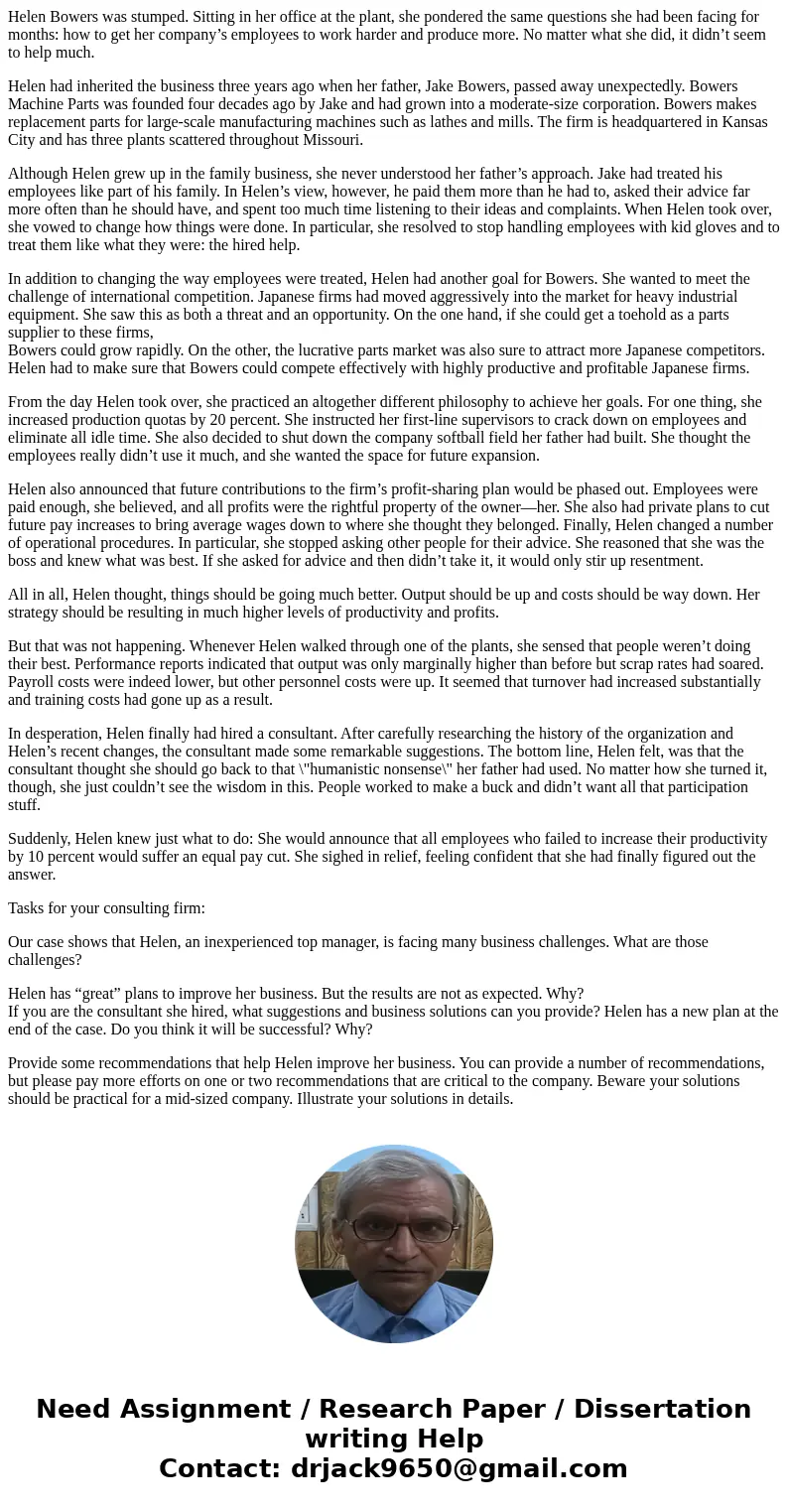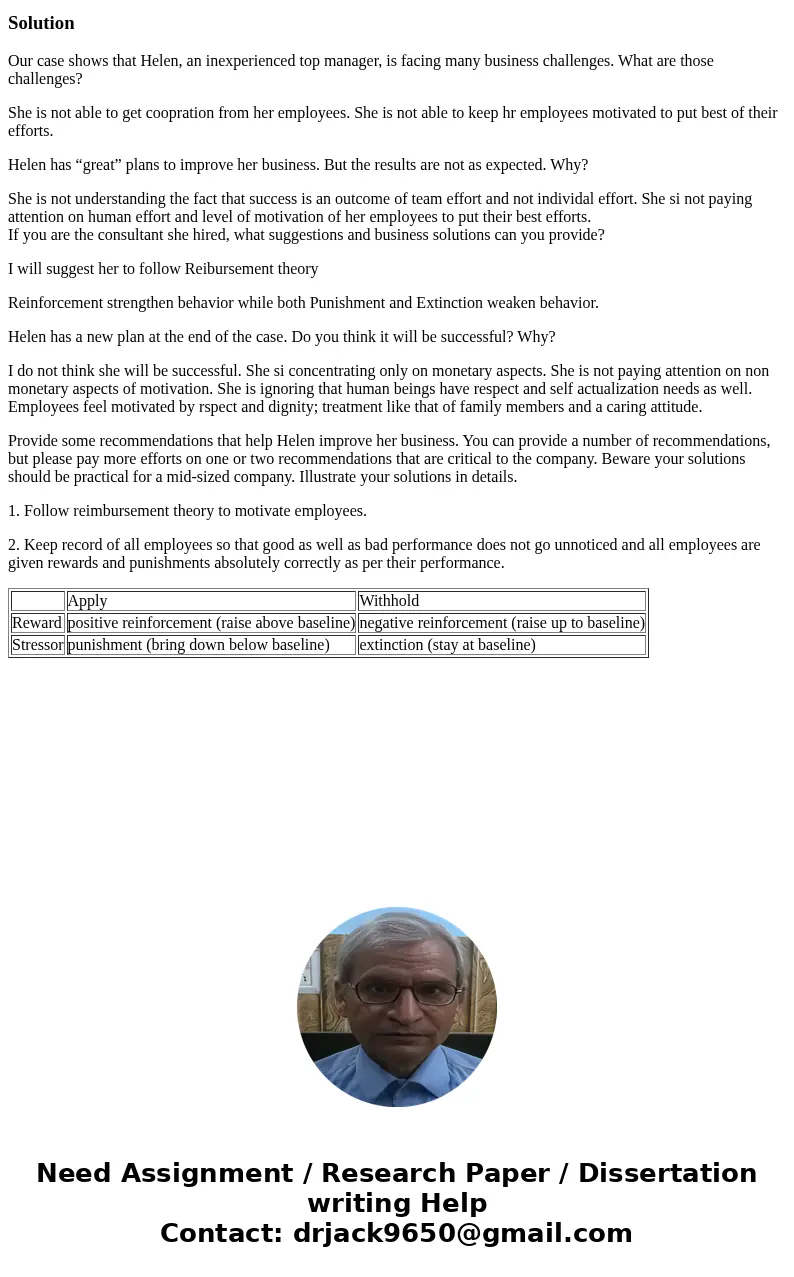Helen Bowers was stumped Sitting in her office at the plant
Helen Bowers was stumped. Sitting in her office at the plant, she pondered the same questions she had been facing for months: how to get her company’s employees to work harder and produce more. No matter what she did, it didn’t seem to help much.
Helen had inherited the business three years ago when her father, Jake Bowers, passed away unexpectedly. Bowers Machine Parts was founded four decades ago by Jake and had grown into a moderate-size corporation. Bowers makes replacement parts for large-scale manufacturing machines such as lathes and mills. The firm is headquartered in Kansas City and has three plants scattered throughout Missouri.
Although Helen grew up in the family business, she never understood her father’s approach. Jake had treated his employees like part of his family. In Helen’s view, however, he paid them more than he had to, asked their advice far more often than he should have, and spent too much time listening to their ideas and complaints. When Helen took over, she vowed to change how things were done. In particular, she resolved to stop handling employees with kid gloves and to treat them like what they were: the hired help.
In addition to changing the way employees were treated, Helen had another goal for Bowers. She wanted to meet the challenge of international competition. Japanese firms had moved aggressively into the market for heavy industrial equipment. She saw this as both a threat and an opportunity. On the one hand, if she could get a toehold as a parts supplier to these firms,
Bowers could grow rapidly. On the other, the lucrative parts market was also sure to attract more Japanese competitors. Helen had to make sure that Bowers could compete effectively with highly productive and profitable Japanese firms.
From the day Helen took over, she practiced an altogether different philosophy to achieve her goals. For one thing, she increased production quotas by 20 percent. She instructed her first-line supervisors to crack down on employees and eliminate all idle time. She also decided to shut down the company softball field her father had built. She thought the employees really didn’t use it much, and she wanted the space for future expansion.
Helen also announced that future contributions to the firm’s profit-sharing plan would be phased out. Employees were paid enough, she believed, and all profits were the rightful property of the owner—her. She also had private plans to cut future pay increases to bring average wages down to where she thought they belonged. Finally, Helen changed a number of operational procedures. In particular, she stopped asking other people for their advice. She reasoned that she was the boss and knew what was best. If she asked for advice and then didn’t take it, it would only stir up resentment.
All in all, Helen thought, things should be going much better. Output should be up and costs should be way down. Her strategy should be resulting in much higher levels of productivity and profits.
But that was not happening. Whenever Helen walked through one of the plants, she sensed that people weren’t doing their best. Performance reports indicated that output was only marginally higher than before but scrap rates had soared. Payroll costs were indeed lower, but other personnel costs were up. It seemed that turnover had increased substantially and training costs had gone up as a result.
In desperation, Helen finally had hired a consultant. After carefully researching the history of the organization and Helen’s recent changes, the consultant made some remarkable suggestions. The bottom line, Helen felt, was that the consultant thought she should go back to that \"humanistic nonsense\" her father had used. No matter how she turned it, though, she just couldn’t see the wisdom in this. People worked to make a buck and didn’t want all that participation stuff.
Suddenly, Helen knew just what to do: She would announce that all employees who failed to increase their productivity by 10 percent would suffer an equal pay cut. She sighed in relief, feeling confident that she had finally figured out the answer.
Tasks for your consulting firm:
Our case shows that Helen, an inexperienced top manager, is facing many business challenges. What are those challenges?
Helen has “great” plans to improve her business. But the results are not as expected. Why?
If you are the consultant she hired, what suggestions and business solutions can you provide? Helen has a new plan at the end of the case. Do you think it will be successful? Why?
Provide some recommendations that help Helen improve her business. You can provide a number of recommendations, but please pay more efforts on one or two recommendations that are critical to the company. Beware your solutions should be practical for a mid-sized company. Illustrate your solutions in details.
Solution
Our case shows that Helen, an inexperienced top manager, is facing many business challenges. What are those challenges?
She is not able to get coopration from her employees. She is not able to keep hr employees motivated to put best of their efforts.
Helen has “great” plans to improve her business. But the results are not as expected. Why?
She is not understanding the fact that success is an outcome of team effort and not individal effort. She si not paying attention on human effort and level of motivation of her employees to put their best efforts.
If you are the consultant she hired, what suggestions and business solutions can you provide?
I will suggest her to follow Reibursement theory
Reinforcement strengthen behavior while both Punishment and Extinction weaken behavior.
Helen has a new plan at the end of the case. Do you think it will be successful? Why?
I do not think she will be successful. She si concentrating only on monetary aspects. She is not paying attention on non monetary aspects of motivation. She is ignoring that human beings have respect and self actualization needs as well. Employees feel motivated by rspect and dignity; treatment like that of family members and a caring attitude.
Provide some recommendations that help Helen improve her business. You can provide a number of recommendations, but please pay more efforts on one or two recommendations that are critical to the company. Beware your solutions should be practical for a mid-sized company. Illustrate your solutions in details.
1. Follow reimbursement theory to motivate employees.
2. Keep record of all employees so that good as well as bad performance does not go unnoticed and all employees are given rewards and punishments absolutely correctly as per their performance.
| Apply | Withhold | |
| Reward | positive reinforcement (raise above baseline) | negative reinforcement (raise up to baseline) |
| Stressor | punishment (bring down below baseline) | extinction (stay at baseline) |


 Homework Sourse
Homework Sourse